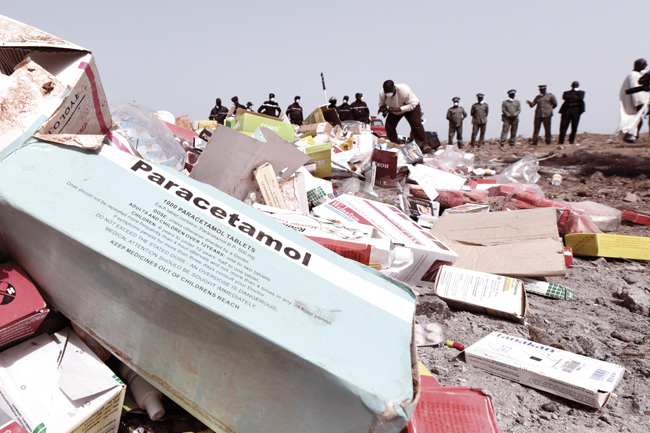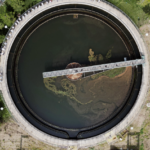Do you take any medicines? Say, heart medication, antibiotics, or perhaps a drug for hypertension? An antiviral or antiretroviral? A prescription for cancer of some kind? Cough syrup? If you have kids, they will most likely have been vaccinated against dread diseases.
Imagine that those medicines or vaccines contained no active ingredients. Or, worse, contained toxic substances that not only fail to treat the condition, but harm your health and potentially endanger your life.
For most of us, it’s unthinkable. If a blister pack of pills looks the part, sealed in foil – accompanied by an insert detailing the ingredients and contraindications, an official-looking brand name and moulded, medicinal-looking tablets – we’re not likely to question it, especially if prescribed by a professional. Yet throughout Africa and South-East Asia, counterfeit medicine is leaving sick, desperate individuals – and even death – in its wake.
The problem is by no means confined to these areas, but they do bear the brunt of the vast majority of counterfeit medicines being circulated throughout the world.
In an article for Africa Renewal Online, Jocelyne Sambira reports that ‘a major sweep across 16 seaports on the east and west coasts of Africa last July allowed the World Customs Organisation, an intergovernmental organisation that advises customs administrations worldwide, to seize more than 82 million doses of illicit medicines estimated to be worth over US$40 million. The fake drugs found during the raid included cough syrup, antiparasitic and antimalarial drugs, antibiotics and even contraceptives’.
Unfortunately, it’s difficult to find reliable statistics on the matter: there is no consolidated database of African pharmaceutical seizures. An organisational crime threat assessment published in 2013 by the United Nations Office on Drugs and Crime (UNODC), focusing on Africa and South-East Asia, however, posited that the counterfeit drug market in Africa is worth about US$4 billion.
In 2009, in Nigeria, 60 out of 225 (27%) antimalarial medications failed chemical analysis, and in Ghana, 14 out of 17 (82%) antimalarial drugs followed suit.
What qualifies a medication as counterfeit? The World Health Organisation (WHO) defines a counterfeit medicine as ‘one that is deliberately and fraudulently mislabelled with respect to identity and/or source. Counterfeiting applies to branded and generic products, and counterfeit products may include those with the correct ingredients or the wrong ingredients, without active ingredients, with insufficient active ingredient, or with fake packaging’.
There are many points at which a drug can be tampered with and made either substandard, ineffective or life-threatening, ranging from the source of the ingredients to the manufacturing process, to incorrect storage and expiry dates.
Counterfeit medicines may contain the wrong ingredients or high levels of impurities, contaminants and even toxic substances.
They could be rejects or out-of-date formulations withdrawn from the market, obtained by counterfeiters, relabelled as bona fide products and introduced back into circulation, says Dr David Benton, outgoing CEO of the International Council of Nurses (ICN). ‘The level of the problem varies from one country to the next. To obtain detailed figures on this is difficult because the very nature of this trade means that much of the information is only partial and hard to verify,’ he says.
The destruction that these faulty medicines wreak is manifold. The most obvious and direct victims are the patients who consume them. There are many instances where widespread harm owing to counterfeit medicine has been recorded, but perhaps one of the most devastating is at least 84 Nigerian children who died in 2009 after taking a syrup for teething pain that contained diethylene glycol, an industrial solvent and an ingredient in antifreeze and brake fluid. And in 2011, nearly 3 000 Kenyans were affected by a falsified batch of their antiretroviral therapy.
‘One myth is that although counterfeit medicines don’t work, they also don’t do any harm,’ says Cyntia Genolet, policy analyst, regulatory and health policy at the International Federation of Pharmaceutical Manufacturers and Associations (IFPMA).
‘Counterfeit medicines won’t treat an illness, and they can worsen the patient’s condition, leading to further illness and disability, and even death. They face no regulatory authority, and can contain no active ingredient, or the wrong one, the wrong dose, or even worse: dangerous substances like paint, rat poison, mercury and antifreeze. Counterfeits are made with no supervision or quality control. In many instances, they are manufactured in garages, warehouses or shacks and stored in unsanitary conditions,’ she says.
Another serious side effect is the development of drug-resistant strains of viruses, bacteria and parasites, or ‘superbugs’, in response to fake medication. Of the world’s malaria deaths, 90% occur in Africa – it’s the leading cause of mortality in many African countries, particularly of children – and there is a constant battle to stay ahead of its ever-evolving resistance to medication. Counterfeit medicines are a huge part of the problem: WHO estimates that about 20% of malaria deaths are because of fake or substandard medicines.
Indirectly, counterfeit drugs place an even greater strain on already heavily burdened health systems, and also work to undermine them by creating mistrust in healthcare professionals, governments, the pharmaceutical industry and all the individuals involved in the distribution of medicines.
The vast majority of fake medicines are produced in China and India, and to a lesser extent, Paraguay and Pakistan, but the UNODC report states that some also come from the local pharmaceutical industry.
Counterfeit medicines may contain the wrong ingredients or high levels of impurities, contaminants and even toxic substances
According to the report: ‘Organised crime flourishes in times of rapid transition, when the old norms no longer apply and the new have yet to take hold … The countries with the most rapidly expanding pharmaceutical industries in the world today are India and China.’ It is also noted that counterfeiters are more likely to select markets that offer the greatest freedom from detection, rather than the greatest potential for profit.
It’s African countries’ absent or weak national regulatory systems for medicines that offer this freedom from detection. According to WHO, legislation and regulations form the basis for medicine regulation. Where they do not exist or are inadequate for proper control of medicines, criminals are encouraged to produce SFFC (spurious/falsely-labelled/falsified/counterfeit) medicines. Inadequate manpower, lack of training and corruption also present challenges.
Yet another obstacle, says Genolet, is that many people ‘are simply not aware of what counterfeit medicines are and the risks they pose. There are plenty of people who simply do not recognise the real danger in purchasing medicines off the street or illegal internet sites instead of using a licensed pharmacy, and do not even consider that experiencing unusual reactions to a medicine they have taken many times before may be the result of a counterfeit product’.
She adds that stopping the global trade in counterfeit medicines is vital and countries should be encouraged to adopt border measures that will stop trade in medicines, in particular fully vesting regulatory, enforcement and customs authorities with the proper power and enough resources to fight counterfeits.
As regards regulatory system strengthening, regional approaches have been taken through organisations such as WAHO (West African Health Organisation), EAC (East African Community), OCEAC (Organisation for the Co-ordination of the Fight against Major Endemic Diseases in Central Africa) and NEPAD (New Partnership for Africa’s Development).
OCEAC is planning a conference on counterfeit medicines in September 2015. Strengthening the legislative framework is a priority for many countries: Guinea, for example, has ratified the Medicrime Convention, a unique international tool criminalising counterfeit medicines. Senegal has strengthened its penal law, and a resolution on fighting counterfeit drugs was approved last year at the Conference of the International Organisation of La Francophonie in Dakar.
In addition, the Fight the Fakes campaign (in which Genolet is active, and which is supported by the ICN and many other major health organisations) was formed to raise awareness about the detrimental impact of counterfeit medicines on communities and healthcare systems. The initiative gives a voice to those who have been affected by fake drugs, and to those fighting their growing threat to public health. It aims to build an international movement that will ‘shine light on the negative impact that counterfeit medicines have on people around the globe’.
‘Many countries are tracking the problem,’ says Benton. ‘We must learn from each other. Just as counterfeit traffic does not respect borders, we must share best practice and learn from each other. That is the way we will save lives.’
















